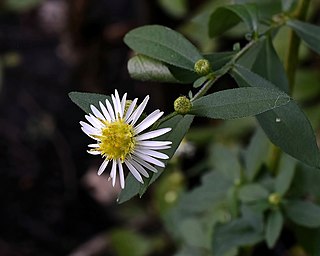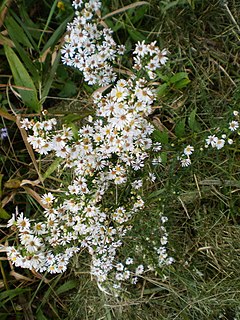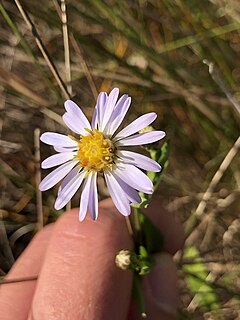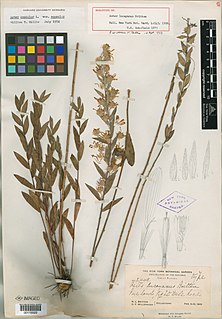
Symphyotrichum lateriflorum is a species of flowering plant of the aster family (Asteraceae) native to eastern and central North America. Commonly known as calico aster, starved aster, and white woodland aster, it is a perennial, herbaceous plant that may reach 120 centimeters high and 30 centimeters across. Each flower head has many tiny florets put together into what appear as one.

Eriocapitella hupehensis, a species of flowering plant in the buttercup family Ranunculaceae, is native to Asia. The specific epithet hupehensis, which means "from Hupeh province, China", refers to a region where the species is known to occur. In Chinese, it is called da po wan hua hua, which means "broken bowl flower".

Solidago gigantea is a North American plant species in the sunflower family. Its common names include tall goldenrod and giant goldenrod, among others.

Lumnitzera is an Indo-West Pacific mangrove genus in the family Combretaceae. An English common name is black mangrove. Lumnitzera, named after the German botanist, Stephan Lumnitzer (1750-1806), occurs in mangroves from East Africa to the Western Pacific, and northern Australia.

Roscoea humeana is a species of flowering plant in the Zingiberaceae family. It is a perennial occurring in the Sichuan and Yunnan provinces of China. Most members of the ginger family, to which it belongs, are tropical, but R. humeana, like other species of Roscoea, grows in much colder mountainous regions. It is sometimes grown as an ornamental plant in gardens.

Symphyotrichum lanceolatum is a species of flowering plant in the family Asteraceae native to North America. Common names include lance-leaved aster, panicled aster, and white panicled aster. It is a perennial, herbaceous plant that may reach 1.5 meters tall or more, sometimes approaching 2 meters. It has a stout rhizome and can spread to form a clonal colony. The species is currently divided into five varieties which have minor differences in appearance and vary in chromosome counts as well as distribution, with some overlap.

Hypericum sechmenii, commonly called seçmen kantaronu in Turkish which means Seçmen's St. John's wort in English, is a rare species of flowering plant of the St. John's wort family (Hypericaceae) that is found only in the Eskişehir Province of central Turkey. It was described by Turkish botanists Atila Ocak and Onur Koyuncu who named the species in honor of Özcan Seçmen, a fellow Turkish botanist. Found in the crevices of exposed limestone, it is a perennial herb which grows in clusters of stems 3–6 centimetres tall and blooms June to July with bright yellow five-petalled flowers. Formally described in 2009, the species was first collected in 2006 and has since been found in only two localities with an estimated population of less than 250.

Hypericum przewalskii, commonly called Przewalski's St. John's wort, is a flowering plant in Hypericumsect. Roscyna that is native to China.

Symphyotrichum ontarionis is a species of flowering plant in the family Asteraceae native to eastern North America. Commonly known as Ontario aster, bottomland aster, and aster du lac Ontario (French), it is a perennial, herbaceous plant that may reach 120 centimeters high. Each flower head has many tiny florets put together into what appear as one.

Symphyotrichum racemosum is a species of flowering plant native to parts of North America. It is known as smooth white oldfield aster, small white aster, and aster à grappes (French). It is a perennial, herbaceous plant in the family Asteraceae. It is a late-summer and fall blooming flower.
Utania racemosa is a species of flowering plant in the family Gentianaceae. It occurs in Southeast Asia from Sumatera in Indonesia to the Andaman Islands in India. Its wood is used for timber and fuel.
Helicia nilagirica is a tree of the Proteaceae family. It grows from Thailand across Mainland Southeast Asia to Yunnan, Zhōngguó/China and over to Nepal. It is a source of wood, a pioneer reafforestation taxa, and an ethnomedicinal plant.
Spathiostemon moniliformis is a plant that can grow as a shrub or a tree in the Euphorbiaceae family, Acalypheae tribe. It is endemic to southern/peninsular Thailand.

Symphyotrichum ciliatus is a species of flowering plant in the family Asteraceae native to North America and eastern Eurasia. Commonly known as rayless annual aster or rayless alkali aster, it is an annual, herbaceous plant that may reach over 70 centimeters high. As composite flowers, each flower head has many tiny florets put together into what appear as one, as do all plants in the family Asteraceae.

Symphyotrichum simmondsii is a species of flowering plant of the aster family (Asteraceae) endemic to the southeastern United States. Commonly known as Simmonds' aster, it is a colony-forming herbaceous perennial that grows 10 cm (4 in) to 120 cm (4 ft) tall from long rhizomes. As composite flowers, each flower head has many tiny florets put together into what appear as one, as do all plants in the family Asteraceae.

Symphyotrichum lucayanum is a species of flowering plant of the aster family (Asteraceae) endemic to the North American island of Grand Bahama.
Strychnos nux-blanda is a shrub or small tree in the Loganiaceae family. It is native to Southeast Asia and Assam. The wood is used as fuel; seeds are toxic, but used in folk-medicine. It is one of the plants featured in the garden of King Narai (1633–88) at Lopburi, Thailand.

Syzygium claviflorum is a tree in the Myrtaceae family. It is native to the north of the Australian continent and in tropical and subtropical Asia. It is used for timber, as fuel, as human and cattle food, and for dye. Stunted specimens can be found on the top of the plateau of Bokor National Park, Cambodia.
Hesperis kotschyi, commonly called Kotschy's damask flower, is a flowering plant in the family Brassicaceae. It is named after the 19th century Austrian botanist Theodor Kotschy. The species is endemic to southern Turkey in the Irano-Turanian floristic region. Hesperis kotschyi is a perennial herb which has lilac colored flowers. Its habitat is among rubble on plateaus at elevations of 1,800–2,300 m (5,900–7,500 ft).
Aporosa octandra is a species of plant in the family Phyllanthaceae found from Queensland and New Guinea to Indonesia, Zhōngguó/China and India. It is a highly variable plant with 4 named varieties. Its wood is used in construction and to make implements, its fruit is edible. The Karbi people of Assam use the plant for dyeing, textile colours have quite some significance in their culture.














